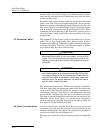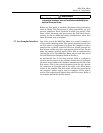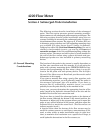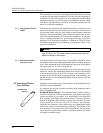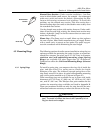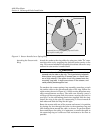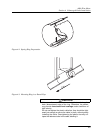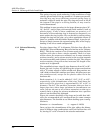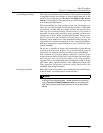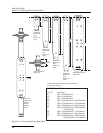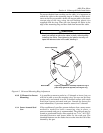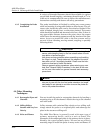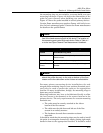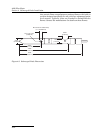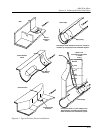
4220 Flow Meter
Section 4 Submerged Probe Installation
4-6
The spring ring may need anchoring. Under conditions of high
velocity (greater than 5 feet per second or 1.5 meters per second),
the ring may not have sufficient outward spring force to
maintain a tight fit inside the pipe. The ring may start to lift off
the bottom of the pipe in a waving fashion, or may even be
carried downstream.
This problem is more prevalent in the larger diameter pipes (10",
12", and 15", and in pipes with smooth inside surfaces, such as
plastic pipes). If any of these conditions are present, or if
movement of the mounting ring is detected or suspected, you
must anchor the ring in place. You can do this by setting screws
through the ring into the pipe, or by other appropriate means. If
there is a problem with the smaller diameter rings, it may be suf-
ficient to simply increase the outward spring force of the ring by
bending it into a less round configuration.
4.3.2 Universal Mounting
Rings
For pipes larger than 15" in diameter, Teledyne Isco offers the
adjustable Universal Mounting Ring (also known as the “Scissors
Ring”). This device consists of two or more metal strips that lock
together with tabs to form a single assembly. There is a base
section where the sensors are mounted, one or more extension
sections (usually), and a scissors section at the top that expands
the entire assembly and tightens it inside the pipe. The scissors
section contains a long screw that increases the length of the
section as it is tightened.
The assembled scissors rings fit pipe diameters from 16" to 80".
Secure the unit in place by tightening the scissors mechanism
with a
5
/8" socket wrench or other suitable tool. Ring sections are
.040" thick half-hard 301 stainless steel sheet. All other parts are
also stainless steel, except for the plastic cable ties in the
hardware kit.
Each extension, 1, 2, 3, and 4, adds 9.0", 21.5", 31.5", or 41.5",
respectively, to the circumference of the ring. Used alone, the
base section fits pipe that is approximately 16" to 18" in
diameter. The 9.0" (the smallest) extension exists so that in
larger pipe sizes, where large variations in circumference can
occur, you can use one or two of these extensions to take up or
remove slack, to bring the scissors mechanism into a position
where it can be effectively tightened.
Figure 4-4 contains drawings of the rings and a table that indi-
cates the recommended part configurations for some common
pipe diameters. The formula to use when deciding upon a config-
uration is:
diameter
x π = circumference (π = approx. 3.14159)
Once you have the circumference of the pipe, add up the dimen-
sions of different ring combinations until you find one that will
fit, leaving 3.5" to 16" of room for the scissors mechanism.



